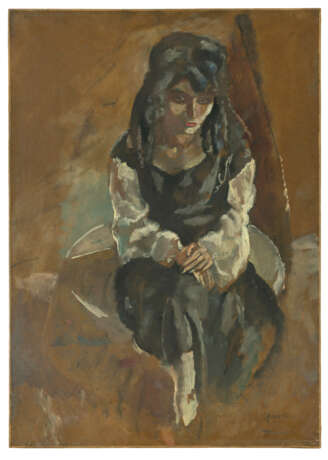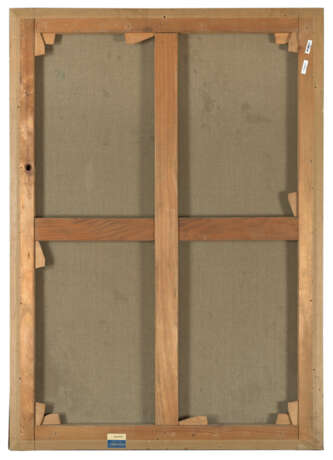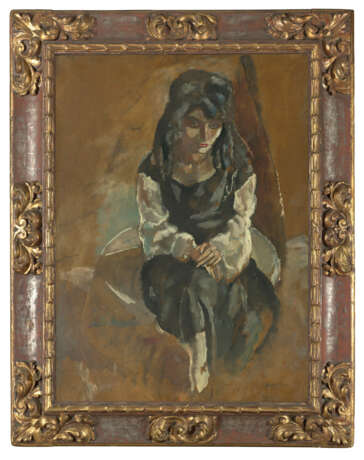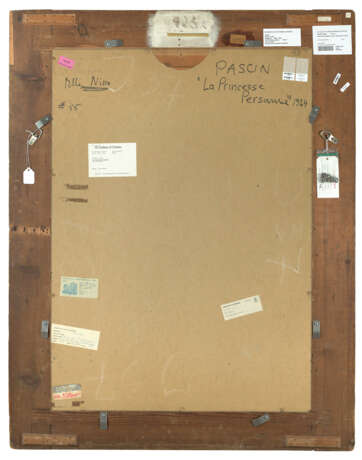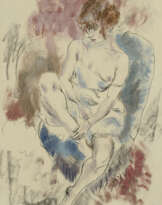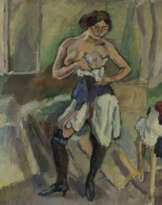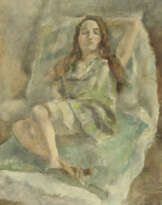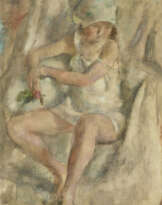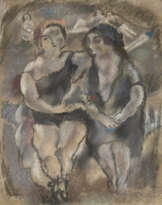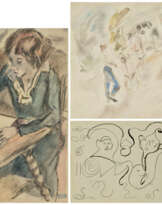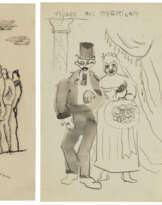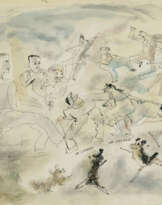ID 1051738
Los 478 | Jules Pascin (1885-1930)
Schätzwert
€ 35 000 – 45 000
La Princesse persane
signé 'Pascin' (en bas à droite)
huile sur papier marouflé sur toile
104 x 73.6 cm.
Peint à Paris en 1923-24
signed 'Pascin' (lower right)
oil on paper laid down on canvas
40 7⁄8 x 29 in.
Painted in Paris in 1923-24
Provenance
Paul Guillaume, Paris.
Galerie Marcel Bernheim, Paris.
Sam Josefowitz, Pully (acquis auprès de celle-ci le 16 juin 1960).
Puis par descendance aux propriétaires actuels.
Literature
(probablement) M. Regnal, Modern French Painters, New York, 1927, p. 254.
Y. Hemin, G. Krohg, K. Perls et A. Rambert, Pascin, Catalogue raisonné, Peintures, aquarelles, pastels, dessins, Paris, 1984, vol. I, p. 246, no. 437 (illustré).
Exhibited
(probablement) New York, Perls Gallery, Pascin, novembre-décembre 1962, no. 11.
Berkeley, University Art Museum; Los Angeles, UCLA Art Galleries; Chapel Hill, Ackland Art Center; Waltham, Rose Art Museum et New York, Whitney Museum of American Art, Pascin, novembre 1966-juin 1967, no. 19.
Munich, Haus der Kunst; Vienne, Wiener Secession; Bordeaux, Galerie des Beaux-Arts; Nice, Palais de la Méditerranée et Genève, Musée d'art et d'histoire, Exposition rétrospective, Pascin, juin 1969-juin 1970, no. 43 (illustré, pl. 43).
(prêt) Toronto, The Art Gallery of Ontario.
Tokyo, Grande Galerie Odakyu; Sapporo, Musée d’Art Moderne de Hokkaïdo; Nagasaki, Musée d’Art de Nagasaki; Yamaguchi, Musée d’Art de Yamaguchi et Osaka, Musée Daimaru, Pascin, Prince des 1001 nuits, avril-septembre 1984, p. 131, no. 36 (illustré, pl. 36).
Further details
C’est en 2014 que je rencontrais Samuel Josefowitz, grand amateur d’art et collectionneur de Pascin. Il me reçut dans sa maison de Lausanne. Je découvris alors avec enchantement son immense collection. J’étais alors commissaire d’une exposition pour le Japon pour laquelle je m’étais empressée de lui proposer de participer. Je me souviens avoir partagé sa table familiale. Il parlait avec admiration de Pascin, de ses talents de dessinateur, et son génie de peintre. Bien qu’il traversât une dure période de deuil, son fils Paul, collectionneur et mécène comme son père, partageant sa passion pour l’Art, était décédé l’année précédente, il se sentait revivre en parlant de Pascin. Il me raconta comment dans la galerie de peintures que tenait Lucy Krohg, la maîtresse mythique de Pascin, à Paris, Place Saint Augustin, il avait découvert Pascin et le caractère spécial de son ancien modèle. Venant régulièrement à Paris pour des raisons professionnelles en qualité de co-fondateur avec son frère David de la maison de disques «Concert Hall», Sam s’était laissé séduire par les œuvres de Pascin et l’étonnante Lucy Krohg. En plus de Pascin, Lucy exposait des œuvres de jeunes peintres contemporains et lorsqu’un collectionneur s’adressait à elle pour Pascin, elle l’obligeait à acheter d’abord ses jeunes artistes. C’était un préalable de bonne guerre auquel Josefowitz se prêta volontiers tant il était tombé sous le charme des œuvres de Pascin. Il voulait tout acheter : les dessins comme les huiles sur toiles. Lucy émue par la sensibilité artistique de ce véritable amateur, et par le fait qu’il résistait à ses refus de vendre, finissait par céder à ses demandes.
L’histoire de ce peintre juif venu de Bulgarie, via l’Allemagne pour rejoindre la capitale mondiale de tous les arts à l’époque, en devenir l’une des stars et l’un des artistes vedette de «L’Ecole de Paris», était passionnante. Pascin retrouve tous les soirs au Dôme ou à la Rotonde, cafés à la mode de Montparnasse, ses amis peintres, écrivains et poètes. Il participe au Salon d'Automne, Berthe Weil l'expose dans sa galerie en 1910. Son destin fut d’un romantisme achevé… Pascin était arrivé à Paris le soir de Noël en 1905, accueilli par de nombreux Montparnos qui l’acclamèrent à sa descente du train. Il arrivait de Munich où il avait collaboré au journal satirique «Le Simplicissimus» avec d’autres surdoués de son genre, Thomas Heine, Alfred Kubin, Georges Grosz et Paul Klee. Une aisance financière lui avait permis de se rendre à Paris rapidement. Il vécut là sa vie durant, excepté l’intermède en Amérique du Nord entre 1914 et 1920 où avec sa jeune épouse, l’artiste Hermine David, peintre et miniaturiste, il vécut à New-York et circula dans le pays.
De retour à Paris en 1920, avec la nationalité américaine au moment où «Les Années Folles» battaient leur plein, il s’y réinstalle pour son plus grand plaisir, lui pour qui les fêtes, l’alcool et les femmes étaient une source d’inspiration inépuisable.
Toujours vêtu de noir, portant chapeau melon et écharpe de soie blanche, sa figure de dandy fit qu’on le compara à un prince venu d’Orient. Il avait épousé Hermine David certes, mais l’amour de sa vie était Lucy Krohg, femme légitime de Per Krohg, peintre norvégien, lui-même ami de Pascin et installé à Montparnasse. Pascin aima passionnément Lucy jusqu’à sa mort. Il avait fait d’elle son héritière, avantage qui lui permit d’ouvrir sa galerie Place Saint Augustin à Paris.
Chantre de l’érotisme, le peintre s’attachait à décrire la beauté et la sensualité du corps féminin. A son retour les plus grands marchands de Paris, tels que Paul Guillaume et Bernheim-Jeune, lui proposèrent des contrats très intéressants. Mais Pascin refusait ce système de soumission et de compromission, ce que d’autres artistes auraient évidemment accepté avec joie. Pascin voulut rester libre, sans engagement, ni contrainte. Il ne résista pas aux conséquences de ce succès jusqu’à se suicider en juin 1930.
Les historiens de Montmartre et Montparnasse considèrent à juste titre que ce drame qui endeuilla le tout Paris marqua la fin des «Années folles».
Rosemarie Napolitano
Expert de l’œuvre de Pascin, Membre de l'Union française des experts, Co-auteur du catalogue raisonné de l’artiste, Vice-Présidente du Comité Pascin
In 2014, I met Samuel Josefowitz, a major art lover and collector of Pascin’s works. I visited him at his house in Lausanne, where I had the great pleasure of viewing his impressive collection. At that time I was the curator of an exhibition in Japan, to wich I quickly asked him to take part. I fondly remember sitting at his family table; he talked about Pascin with great admiration, about his talents as a draftsman, and his genius as a painter. Although he was going through a difficult period of mourning, following the recent death of his son Paul, who had shared his passion for art, and had been a collector and patron like his father, he seemed to come alive once again whilst talking about Pascin. He reminisced about how he had discovered Pascin, in the gallery located Place Saint Augustin in Paris, run by Lucy Krohg, Pascin’s legendary mistress. He travelled frequently to Paris for professional reasons, being the co-founder with his brother David of the “Concert Hall” record company. Josefowitz was not only captivated by Pascin’s works, but also byt the astonishing Lucy Krohg. Alongside Pascin, Lucy exhibited works by young contemporary painters, and when collectors approached her for works by Pascin, she made them buy pieces by her young artists first. This was a fine prerequisite, which Josefowitz willingly agreed to, as he had fallen under the charm of Pascin’s works. He wanted to purchase everything: his drawings as well as his oil paintings. Lucy, who was moved by the artistic sensitivity of this true art lover, and by the fact that he resisted her refusals to sell, ended up by conceding to his requests.
This Jewish painter, originally came from Bulgaria, via Germany, reaching the world capital of all forms of arts at that time, where he became one of the key artists of the Paris School. Every evening, at the Dôme or the Rotonde, the fashionable cafés in Montparnasse, Pascin met up with his friends, who were painters, writers, and poets. He took part in the Salon d’Autonne, and Berthe Weil exhibited his works in her gallery in 1910. His destiny was one of complete romanticism... Pascin arrived in Paris on Christmas Eve, 1905, greated by several figures from the Montparnasse set, who cheered him as he got off the train. He had arrived from Munich, where he had worked on the satirical newspaper “Le Simplicissimus”, with other gifted people like himself, including Thomas Heine, Alfred Kubin, Georges Grosz, and Paul Klee. His comfortable financial situation allowed him to rapidly move to Paris. He spent the rest of his life there, apart from an interlude in North America, between 1914 and 1920, where, along with his young wife, the artist Hermine David, the painter and miniaturist, he lived in New York and travelled around the country.
He returned to Paris in 1920, with his American nationality, whilst “The Roaring Twenties” were in full swing. He settled again in Paris to enjoy his greatest pleasures, where parties, alcohol and women were an inexhaustible source of inspiration for him.
Always dressed in black, and wearing a bowler hat and a white silk scarf, his dandy image led people to compare him to an oriental prince. Despite marrying Hermine David, the love of his life was Lucy Krohg, the wife of Per Krohg, a Norwegian painter, who was a friend of Pascin, based in Montparnasse. Pascin was passionately in love with Lucy until his death. He named her as his heir, which ultimately allowed her to open her gallery in Place Saint Augustin, in Paris.
A champion of eroticism, Pascin set about describing the beauty and sensuality of the female body. On his return, the greatest dealers in Paris, including Paul Guillaume and Bernheim Jeune, offered him some very attractive deals. However, Pascin refused this system of submission and compromise, which other artists would have readily and gratefully accepted. Pascin wanted to be free, with no commitments or constraints. He could not withstand the consequences of this success, and committed suicide in June, 1930.
The historians of Montmartre and Montparnasse quite rightly consider that this tragedy, which plunged all of Paris into mourning, marked the end of the “Roaring Twenties.”
Rosemarie Napolitano
Expert on the work of Pascin, member of the Union Française des Experts, co-author of the artist’s catalogue raisonné, and Vice-President of the Comité Pascin
| Künstler: | Jules Pascin (1885 - 1930) |
|---|---|
| Angewandte Technik: | Öl auf Leinwand |
| Kategorie des Auktionshauses: | Gemälde |
| Künstler: | Jules Pascin (1885 - 1930) |
|---|---|
| Angewandte Technik: | Öl auf Leinwand |
| Kategorie des Auktionshauses: | Gemälde |
| Adresse der Versteigerung |
CHRISTIE'S 9 Avenue Matignon 75008 Paris Frankreich | ||||||||||||||
|---|---|---|---|---|---|---|---|---|---|---|---|---|---|---|---|
| Vorschau |
| ||||||||||||||
| Telefon | +33 (0)1 40 76 85 85 | ||||||||||||||
| Fax | +33 (0)1 40 76 85 86 | ||||||||||||||
| Nutzungsbedingungen | Nutzungsbedingungen | ||||||||||||||
| Versand |
Postdienst Kurierdienst Selbstabholung | ||||||||||||||
| Zahlungsarten |
Banküberweisung | ||||||||||||||
| Geschäftszeiten | Geschäftszeiten
|

